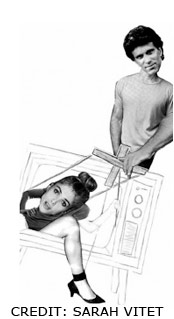Late night discrimination

VANCOUVER (CUP) - There seems to be an uprising of TV shows featuring one girl amongst the ranks of men (The Big Bang Theory and Zooey Deschanel's New Girl, to name a few). These shows are likely representations of the offices where many TV shows are written, with one quirky female amongst an entourage of men.
In a book about the history of Saturday Night Live (SNL) called Live From New York, political satirist and one of the original writers of SNL Al Franken is quoted as saying, “Saturday Night Live was a very positive experience for all of us. It was really just a wonderful fucking thing for everybody.”
“All of us” was apparently non-encompassing. Men have a very different experience working at SNL than women. On the next page of the same book, Janeane Garofalo, who worked on SNL from 1994 to 1995, explains her reason for leaving the show, stating, “Life is a boy's club. So SNL is a reflection of that. I'll admit that I was not ready to deal with that wall of resistance.”
This boy's club scenario is not specific to SNL. In 2009, there were no women writers on the The Jay Leno Show, The Late Show with David Letterman and The Tonight Show with Conan O'Brien. There was one on The Late Late Show with Craig Ferguson: his younger sister, Lynn Ferguson. The lone female writing for Jimmy Kimmel Live! is the host's girlfriend.
Late night TV isn't the only sector of television that suffers from a lack of female writers. Amongst prime-time TV writers, a mere 15 per cent are female, down from 35 per cent in 2006. Since the writers' strike in 2007, the female writer has become a dying breed — and apparently to be a female writer for late night TV, you may have to be related to the host or sleeping with him.
The main detriment of losing female writers is that female characters are being primarily written by men, and therefore can be easily misrepresented. Men will be more inclined to write their ideal female characters instead of more realistic females, as a woman could write from experience. This may fuel the demeaning ideal of the “perfect female,” which is already a symbol in mass media: a size-four woman who can eat endless amounts of potato chips and not get a belly, who looks perfect in the morning and wakes up without morning breath and who never suffers from PMS. If young females see these characters, they may strive to be more like them, creating a new kind of Barbie syndrome.
In an article in the Huffington Post, Maureen Ryan pinpointed advertisers as one of the main reasons why the female writer is becoming increasingly rare. “We're not making art out here, we're making programming that allows networks to sell ad dollars,” says Jill Soloway, one of Ryan's sources and a writer for Six Feet Under and How to Make It in America. “The only ad dollars that appeal solely to women only are diapers and cleaning products.”
Male writer Kurt Sutter echoes that view in an interview on Vulture.com: “Just look at the primary measuring statistic for a viewing audience; the only statistic that matters financially — males 18 to 49. Networks demand that shows be aimed at that target audience. They have to. That's what advertisers demand of them. No ads, no TV. So by default, for the most part, we are creating television for white guys,” he says. And who better to write for white guys between the ages of 18 to 49 than white guys in that exact age bracket?
With advertisers meddling in the creative process of television writers, the chance of seeing an increase in females writing for network television is slim. As Jill Soloway explained to Maureen Ryan, “Sometimes I watch Louie, which, for my money, is one of the best shows I have ever seen on television, and wonder if � a network would air a show where a woman was talking about masturbating and farting (in an awesomely deep way, mind you). The answer is no — not because networks hate women, not because studios refuse to hire women creators — but because there is no brand that would be willing to be associated with the idea of such an antiheroic woman.”
You can help fix the root of the female writer problem by supporting stations that support female writers. That might mean donating to a public broadcaster. The chances of seeing more female writers on programs created for publicly funded television, such as PBS, are greater. Maybe, instead of tolerating “ideal” female characters written by men, we should contribute to ideal television networks that have creative control without interference from advertising bullies. Such networks can foster female writers and their realistic female characters.
We know that there are good female writers. They just need a broadcaster that won't be prejudiced against the type of women they represent and write about. Until men and advertisers are comfortable hearing about strong women who menstruate, we won't be seeing it on network television.
Editorial opinions or comments expressed in this online edition of Interrobang newspaper reflect the views of the writer and are not those of the Interrobang or the Fanshawe Student Union. The Interrobang is published weekly by the Fanshawe Student Union at 1001 Fanshawe College Blvd., P.O. Box 7005, London, Ontario, N5Y 5R6 and distributed through the Fanshawe College community. Letters to the editor are welcome. All letters are subject to editing and should be emailed. All letters must be accompanied by contact information. Letters can also be submitted online by clicking here.













